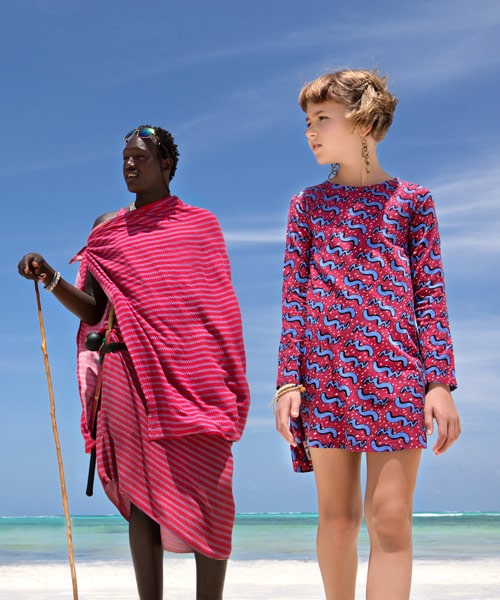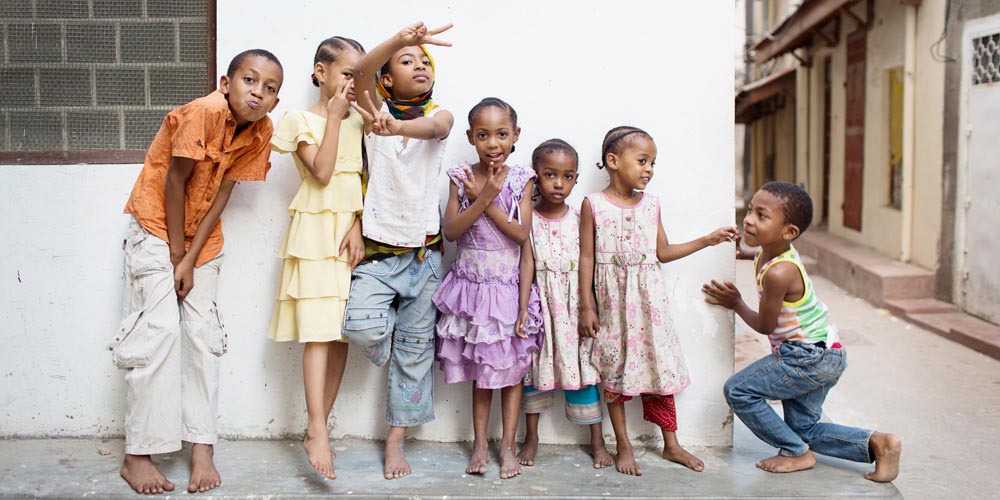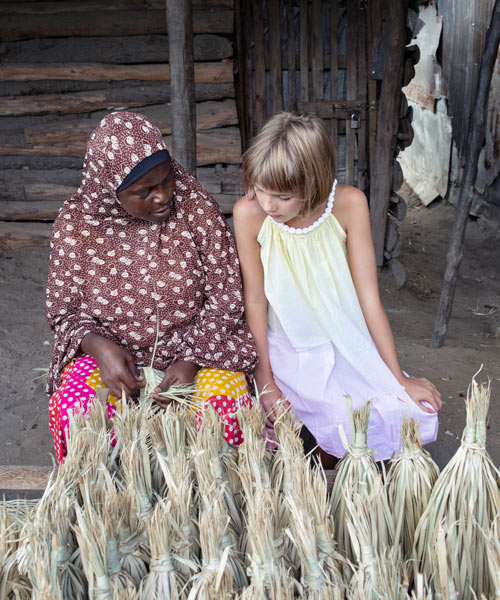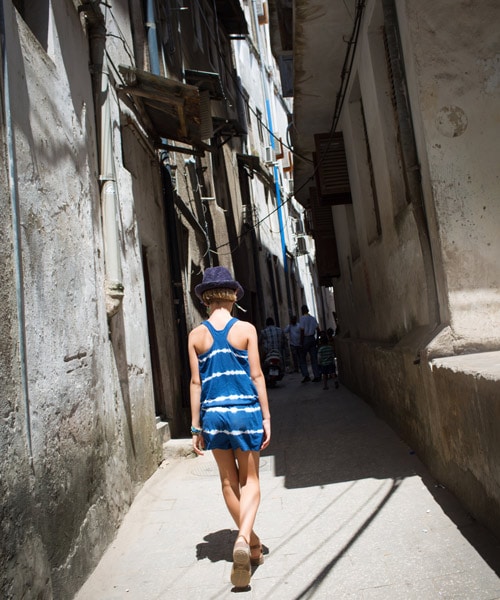Abi Campbell and her entrepreneurial 10-year-old daughter Jemima are spellbound by the African island of Zanzibar – so much so, they want to set up shop

Jemima by The Rock on Michanwi Pingwe beach
Jemima and I had been in Zanzibar for three days when we hatched our cunning business plan: to open a groovy coffee shop in the capital, Stone Town, aimed at the discerning traveller. We’d use the best African beans available and spike it with a kaleidoscope of locally grown island spices. We’d design and sell artisan jewellery and souvenirs at our in-house boutique, handmade by the local villagers we’d befriended. We shook on it, agreeing to throw the towel in on dreary old England and the whole ‘school thingy’. Now we’d found paradise, we weren’t leaving. No way.
Sadly I’m writing this at 25,000ft, while Jemima’s is tucking into a surprisingly appetising Qatar Airways kids’ meal. Our grand plan didn’t pan out. No worries, though, because as we catapulted down the runway into the comedy-orange Tanzanian sunset we made a pact. We’d find a way to come back again really soon – we just had a few small commitments to tie up back home first.
Ordinarily, I’m a control freak about planning travel itineraries, but on this occasion I’d been introduced to one of the island’s most trusted operators, Xperience Tours.

Jemima makes new friends on a guided village tour
On a short visit, it made perfect sense to evaporate stress by passing the logistics to a guide.
Fadhil greeted us at the airport in our own private air-conditioned minivan with driver and took us to the east coast and our home for a week, the delightfully laidback Breezes Beach Club. On the hour-long journey, Fadhil gave us a historical and cultural overview of the island and we instantly warmed to him. He handed me a ‘menu’ of excursions, telling us he was at our disposal and I felt like a kid in a sweet shop. We agreed to meet the next day at a lazy 12pm to visit The Rock on Michanwi Pingwe beach.
The Rock is the sort of place you’d stumble upon in a ‘100 places to go before you die’ book. A random bit of craggy rock posited precariously in a dayglow sea, it simply doesn’t look real – and quirkier still, it’s a restaurant. When we disembarked from the tender, I was fully expecting to see a local man cooking line-caught fish over coals in an oil drum. Instead, we were greeted by an arresting Maasai warrior and Nigel, the eccentric English owner.

Jemima meets a local Maasai warrior

Friendly children in Stone Town, the capital of Zanzibar
We dined on delicious Italian/African fusion cuisine and sat on the sun-bleached terrace rubbing our eyes at the staggering beauty of the Indian Ocean. Jemima suggested that, ‘This is what heaven must look like’, and I agreed. After our lunch among the well-heeled tourist massive we headed to a local village, to find a starkly different Zanzibar. Children with bare feet in worn-out primary-colour party dresses greeted us with interest. We were guided through higgledy-piggledy mud huts with palm-frond roofs, dodging skinny chickens and goats along the way.
A man handed Jemima a green coconut and instructed her how to remove the husk with a metal spike. A mother cracked the nut and handed it to the baby on her lap to drain the water, then showed Jemima how to grate the flesh out and extract the milk. Then to an old woman with boney fingers, spinning the mangrove-marinated husk into raffia in her palms, later to be dyed and made into bags, mats and baskets. The journey of this single natural resource was sobering. No waste, every part utilised, highlighting the uncomfortable truth about our throw-away society in the West.

Jemima is taught to husk a coconut

Basket weaving is an important local skill
The ladies took pleasure in wrapping me in a kanga (sarong), using mostly sign language to communicate, but smiles were universal, and there was no shortage of those when Jemima produced her iPod and passed the earphones to the children crowded around like her groupies. It was one of those magical moments when humans connect and transcend all barriers. Zanzibar is known for its heady aromatic spices, hence its alias, The Spice Island. A spice tour is a tick-box attraction for any visitor, and it’s about as eco-friendly as you can get. These are working farms, and there are no gaudy souvenir shops, just an open-sided hut with bags of harvested spices, should you fancy taking some home for the rellies.
Our attention was caught by a voice high in the lofty palm-tree canopy: ‘Jambo, jambo, bwana…’ Jemima and I rushed over to see a pair of feet protruding from the leaves 70ft above our heads. Coconuts rained down intermittently as the man cut them loose, then he nimbly shimmied meeting the locals in stone town down the trunk while belting out the Lion King classic Hakuna Matata. If there were a Zanzibar’s Got Talent, Jemima and I agreed, he would be a firm contender.

Exploring Stone Town’s network of alleyways
On the tour, our host carved off a slice of bark and asked Jemima if she knew what it might be. She lifted the sample to her nose and her face lit up as the aroma of her favourite pancake dusting collided with her sensory receptors. Things continued in that vein, uncovering the natural source of cloves, vanilla, lemon grass, ginger, turmeric, alongside a narrative on their origin, uses and healing properties. Our guide fashioned every little girl’s dream collection of accessories out of pineapple leaves as we walked. A handbag, a pair of sunglasses, and a little frog… a prince, perhaps, as her final gift was a majestic leaf and flower crown worthy of a real princess.
We headed to nearby Stone Town for lunch and I asked Fadhil to bypass tourist traps and take us to his favourite eatery. Lukmaan Restaurant was a no-frills joint, serving fresh juices and delicious curries packed with all the spices we’d just sampled. Afterwards, we walked the warren of narrow alleyways on a treasure hunt for famous ancient Zanzibarian doors showcasing early Arabic and Indian architectural influences. Jemima played with kids on the street and I sat on a time worn doorstep, happy to watch new friendships unfold.

Family Traveller writer and photographer Abi Campbell hangs out with the locals
In the weeks before our trip, Jemima and I were obsessively Googling images, going gaga over photos of wooden fishing dhows with their magnificent sails. So, naturally, we jumped at the opportunity to take Safari Blue’s excursion to the outlying island of Kwale. It was a choppy crossing on what felt like a tree trunk, but we were rewarded with a Robinson Crusoe-style lunch of grilled lobster and fruit on a sandbank. We snorkelled and, afterwards, steered the boat into to a hidden blue lagoon that resembled the forgotten world. Watching the sun disappear into the horizon as we sailed back with my intrepid daughter by my side was a nigh-on religious experience.
Zanzibar’s greatest seduction is, of course, its miles of spotless sand beaches fringed with turquoise sea. I’d go so far as to say it’s on par with the Maldives, but without the disadvantages of being stranded on a tiny atoll with no escape. There were times in the day when Jemima and I walked for 300m into the ocean towards the reef and were still only waist-deep in glassy, bath-warm water with unblighted velvety soft sand underfoot.

Jemima on the dhow trip to Kwale Island

Jemima tests the waters at Baraza Resort & Spa, Zanzibar
From Breezes’ hotel beach, we took a reef walk, now on my top five travel experiences ever. With borrowed rubber shoes and a stick for balance, we picked our way across the ocean floor for an hour to where the waves broke. We saw sea sponges, brittle stars, urchins, gigantic, bright crimson starfish and a plethora of other unrecognisable creatures. In the few hours that the sea retreated, it unveiled all the treasures and secrets of an alien world we humans barely know exists. For young children who cannot snorkel or dive, it will blow their minds.
With the help of Fadhil, we packed our remaining days with a visit to the Maruhubi Palace Ruins, the Jozani Chwaka Bay National Park to track down Colobus monkeys, and explored the mangrove swamps. It felt as if we ran out of time, as there is so much distraction in this beautiful country. Our overriding memory of Zanzibar will not be of beaches or attractions, though, but of the people we met while we were there.
We returned to the UK emotionally invested in one particular community, having visited a local school there that was pitifully underfunded. We have since set up a charity that has raised £2,000 to build a new classroom for the children we met.
Next year, when the project is completed, we have been invited to go back to see it. So, you see, I’m a fatalist and our little coffee shop may not be a nutty pipe dream after all – we may get our little slice of paradise yet.
Hakuna Matata! What a wonderful phrase, Hakuna Matata! Ain’t no passing craze, It means no worries, For the rest of your days, Hakuna Matata!

Jemima poses with local school girls in Zanzibar
HOW TO GET THERE
Qatar Airways flies from Heathrow to Zanzibar (12-hour flight) from £499 return.
WHERE TO STAY
Breezes Beach Club Deluxe Room, two adults and two children sharing half-board, from £273 per night. thezanzibarcollection.com Baraza Resort and Spa Two-bedroom Garden View Villa. Two adults and two
children sharing all-inclusive, from £697 per night. thezanzibarcollection.com
WHAT TO DO
Jozani Chwaka Bay National Park Lunch at the Rock, Muungoni Village visit. From £40pp
Spice Tour and Stone Town visit From £38pp
Safari Blue Dhow to Island with lunch (full day) From £50pp
All excursions and transfers booked were booked through Xperience Tours Travel. xperiencetourstravel.co.tz
WHERE TO EAT
Lukmann Restaurant +255 777 482 131
The Rock Restaurant, therockrestaurantzanzibar.com